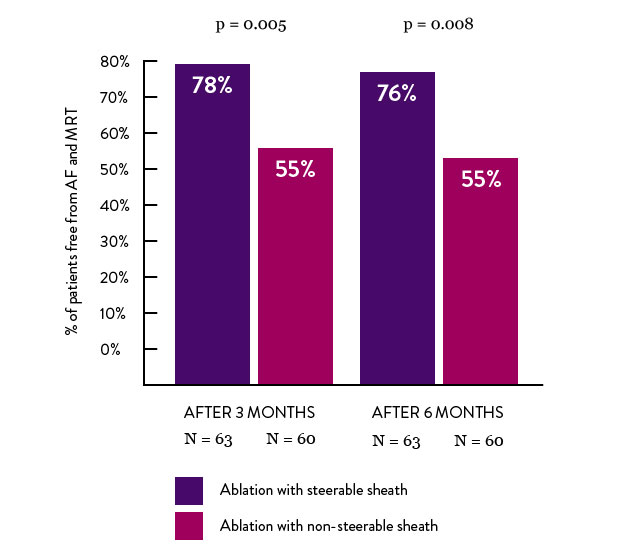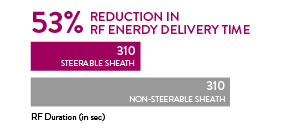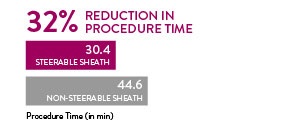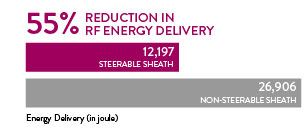Clinical Evidence
The sheath of the Agilis™ NxT steerable introducer promotes improved contact force (CF) parameters during pulmonary vein isolation. In a study conducted by the Keio University School of Medicine, Tokyo, Japan, the average CF was significantly higher when using the Agilis™ sheaths compared to the Swartz™ sheaths, especially in the inferior/anterior wall of the RPV and the roof/carina of the LPV.1
The Agilis NxT steerable introducer improves access to hard-to-reach sites, and can be adjusted to aid various anatomic approaches—eliminating the need to change out sheaths in order to reach the desired position.2 Its soft, atraumatic tip reduces potential for trauma during transseptal punctures, and provides a smooth transition to catheter.
Clinical Findings
In clinical studies, the use of the Agilis NxT steerable introducer was associated with:
- Higher rates of complete pulmonary vein isolation at 6 months3
- Higher rate of freedom from atrial fibrillation (AF) at 6 months3,4
- Significantly higher single procedure success rate post-AF ablation4
- Lower rates of post-op cardioversion after AF ablation3
- Less use of antiarrhythmic medications post-6 months AF ablation3
- Fewer reablation for symptomatic drug refractory AF recurrences3
- Reduction in procedure time during CTI5
- Lower fluoroscopy time during AF ablation4
- Less total radio frequency (RF) energy delivery during CTI and AF ablation3,5
- Reduction in RF delivery time during CTI ablation5
- Higher average contact force in AF ablation6
Read the TOCCASTAR clinical study.
Randomized Study of Steerable vs. Non-Steerable Sheath Technology
In a randomized study of steerable versus non-steerable sheath technology in AF ablation, significantly higher single-procedure success was achieved when the ablation catheter was supported by the Agilis NxT steerable introducer, versus a fixed guiding introducer.2
Steerable Versus Non-Steerable Sheath Technology in AF Ablation: Data from a Prospective, Randomized Study2
Studies also found that procedural efficacy was improved during cavotricuspid isthmus ablation when the ablation catheter* was supported by the Agilis NxT steerable introducer, versus a fixed guiding introducer.7

Prospective Randomized Comparison of a Steerable Versus a Non-Steerable Sheath for Typical Atrial Flutter Ablation7
All statements related to improvements in catheter manipulation, control and access are based on the design of the Agilis NxT steerable introducer, and are in comparison to a fixed curve, non-steerable sheath.



This device is commercially available for use in select international markets.
*Ablation catheter used in conjunction with the Agilis NxT steerable introducer: Boston Scientific Blazer™ II XP, 8 mm tip.
References
- Kimura, T., Takatsuki, S., Oishi, A., Negishi, M., Kashimura, S., Katsumata, Y., . . . Fukuda, K. (2014). Operator-blinded contact force monitoring during pulmonary vein isolation using conventional and steerable sheaths. International Journal of Cardiology, 177(3), 970-976. https://dx.doi.org/10.1016/j.ijcard.2014.09.189
- Masuda, M., Fujita, M., Iida, O., Okamoto, S., Ishihara, T., Nanto, K., . . . Uematsu, M. (2016). Steerable versus non-steerable sheaths during pulmonary vein isolation: Impact of left atrial enlargement on the catheter-tissue contact force. Journal of Interventional Cardiac Electrophysiology, 47(1), 99-107. https://doi.org/10.1007/s10840-016-0135-4
- Piorkowski, C., Kottkamp, H., Gerds-Li, J. H., Arya, A., Sommers, P., Dagres, N., Hindricks, G. (2008). Steerable sheath catheter navigation for ablation of atrial fibrillation: A case-control study. Pacing and Clinical Electrophysiology, 31(7), 863-873. https://dx.doi.org/10.1111/j.1540-8159.2008.01101.x
- Piorkowski, C., Eitel C., Rolf, S., Bode, K., Sommer, P., Gaspar, T., … Hindricks, G.(2011). Steerable versus non-steerable sheath technology in AF ablation: A prospective, randomized study. Circulation, 4(2), 157-65. https://dx.doi.org/10.1161/CIRCEP.110.957761
- Matsuo, S., Yamane, T., Tokuda, M., Date. T., Hioki, M., Narui, R., … Yoshimura, M. (2012). Prospective randomized comparison of a steerable versus a non-steerable sheath for typical atrial flutter ablation. Europace, 12(3), 402-9. https://dx.doi.org/10.1093/europace/eup434
- Mansour, M. (2014, May). TOCCASTAR: Preliminary results of the first prospective randomized study of a contact force sensing ablation catheter for the treatment of paroxysmal AF. Presented at the meeting of the Heart Rhythm Society, San Francisco, CA.
MAT-2101187 v1.0
